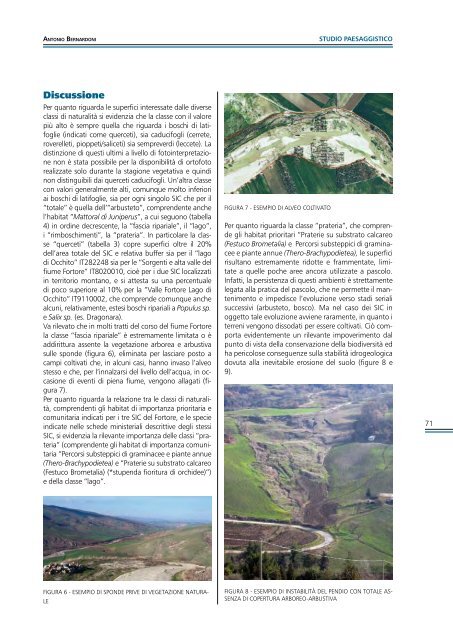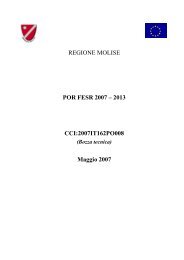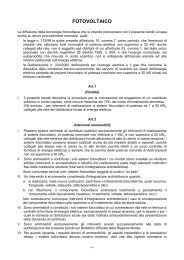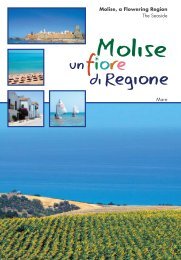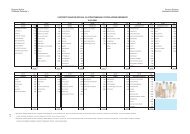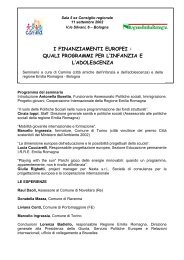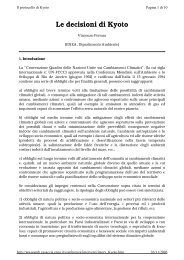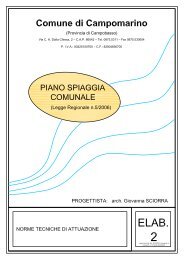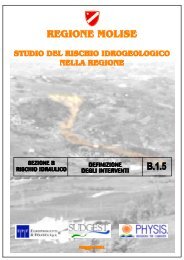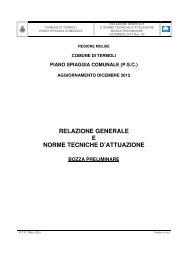Il fiume Fortore - Studi preliminari al piano di gestione dei SIC
Il fiume Fortore - Studi preliminari al piano di gestione dei SIC
Il fiume Fortore - Studi preliminari al piano di gestione dei SIC
Create successful ePaper yourself
Turn your PDF publications into a flip-book with our unique Google optimized e-Paper software.
An t o n io Be r n a r d o n i<br />
STUDIO PAESAGGISTICO<br />
Discussione<br />
Per quanto riguarda le superfici interessate d<strong>al</strong>le <strong>di</strong>verse<br />
classi <strong>di</strong> natur<strong>al</strong>ità si evidenzia che la classe con il v<strong>al</strong>ore<br />
più <strong>al</strong>to è sempre quella che riguarda i boschi <strong>di</strong> latifoglie<br />
(in<strong>di</strong>cati come querceti), sia caducifogli (cerrete,<br />
roverelleti, pioppeti/s<strong>al</strong>iceti) sia semprever<strong>di</strong> (leccete). La<br />
<strong>di</strong>stinzione <strong>di</strong> questi ultimi a livello <strong>di</strong> fotointerpretazione<br />
non è stata possibile per la <strong>di</strong>sponibilità <strong>di</strong> ortofoto<br />
re<strong>al</strong>izzate solo durante la stagione vegetativa e quin<strong>di</strong><br />
non <strong>di</strong>stinguibili dai querceti caducifogli. Un’<strong>al</strong>tra classe<br />
con v<strong>al</strong>ori gener<strong>al</strong>mente <strong>al</strong>ti, comunque molto inferiori<br />
ai boschi <strong>di</strong> latifoglie, sia per ogni singolo <strong>SIC</strong> che per il<br />
“tot<strong>al</strong>e” è quella dell’”arbusteto”, comprendente anche<br />
l’habitat “Mattor<strong>al</strong> <strong>di</strong> Juniperus”, a cui seguono (tabella<br />
4) in or<strong>di</strong>ne decrescente, la “fascia ripari<strong>al</strong>e”, il “lago”,<br />
i “rimboschimenti”, la “prateria”. In particolare la classe<br />
“querceti” (tabella 3) copre superfici oltre il 20%<br />
dell’area tot<strong>al</strong>e del <strong>SIC</strong> e relativa buffer sia per il “lago<br />
<strong>di</strong> Occhito” IT282248 sia per le “Sorgenti e <strong>al</strong>ta v<strong>al</strong>le del<br />
<strong>fiume</strong> <strong>Fortore</strong>” IT8020010, cioè per i due <strong>SIC</strong> loc<strong>al</strong>izzati<br />
in territorio montano, e si attesta su una percentu<strong>al</strong>e<br />
<strong>di</strong> poco superiore <strong>al</strong> 10% per la “V<strong>al</strong>le <strong>Fortore</strong> Lago <strong>di</strong><br />
Occhito” IT9110002, che comprende comunque anche<br />
<strong>al</strong>cuni, relativamente, estesi boschi ripari<strong>al</strong>i a Populus sp.<br />
e S<strong>al</strong>ix sp. (es. Dragonara).<br />
Va rilevato che in molti tratti del corso del <strong>fiume</strong> <strong>Fortore</strong><br />
la classe “fascia ripari<strong>al</strong>e” è estremamente limitata o è<br />
ad<strong>di</strong>rittura assente la vegetazione arborea e arbustiva<br />
sulle sponde (figura 6), eliminata per lasciare posto a<br />
campi coltivati che, in <strong>al</strong>cuni casi, hanno invaso l’<strong>al</strong>veo<br />
stesso e che, per l’inn<strong>al</strong>zarsi del livello dell’acqua, in occasione<br />
<strong>di</strong> eventi <strong>di</strong> piena <strong>fiume</strong>, vengono <strong>al</strong>lagati (figura<br />
7).<br />
Per quanto riguarda la relazione tra le classi <strong>di</strong> natur<strong>al</strong>ità,<br />
comprendenti gli habitat <strong>di</strong> importanza prioritaria e<br />
comunitaria in<strong>di</strong>cati per i tre <strong>SIC</strong> del <strong>Fortore</strong>, e le specie<br />
in<strong>di</strong>cate nelle schede ministeri<strong>al</strong>i descrittive degli stessi<br />
<strong>SIC</strong>, si evidenzia la rilevante importanza delle classi “prateria”<br />
(comprendente gli habitat <strong>di</strong> importanza comunitaria<br />
“Percorsi substeppici <strong>di</strong> graminacee e piante annue<br />
(Thero-Brachypo<strong>di</strong>etea) e “Praterie su substrato c<strong>al</strong>careo<br />
(Festuco Bromet<strong>al</strong>ia) (*stupenda fioritura <strong>di</strong> orchidee)”)<br />
e della classe “lago”.<br />
Figura 7 - Esempio <strong>di</strong> <strong>al</strong>veo coltivato<br />
Per quanto riguarda la classe “prateria”, che comprende<br />
gli habitat prioritari “Praterie su substrato c<strong>al</strong>careo<br />
(Festuco Bromet<strong>al</strong>ia) e Percorsi substeppici <strong>di</strong> graminacee<br />
e piante annue (Thero-Brachypo<strong>di</strong>etea), le superfici<br />
risultano estremamente ridotte e frammentate, limitate<br />
a quelle poche aree ancora utilizzate a pascolo.<br />
Infatti, la persistenza <strong>di</strong> questi ambienti è strettamente<br />
legata <strong>al</strong>la pratica del pascolo, che ne permette il mantenimento<br />
e impe<strong>di</strong>sce l’evoluzione verso sta<strong>di</strong> seri<strong>al</strong>i<br />
successivi (arbusteto, bosco). Ma nel caso <strong>dei</strong> <strong>SIC</strong> in<br />
oggetto t<strong>al</strong>e evoluzione avviene raramente, in quanto i<br />
terreni vengono <strong>di</strong>ssodati per essere coltivati. Ciò comporta<br />
evidentemente un rilevante impoverimento d<strong>al</strong><br />
punto <strong>di</strong> vista della conservazione della bio<strong>di</strong>versità ed<br />
ha pericolose conseguenze sulla stabilità idrogeologica<br />
dovuta <strong>al</strong>la inevitabile erosione del suolo (figure 8 e<br />
9).<br />
71<br />
Figura 6 - Esempio <strong>di</strong> sponde prive <strong>di</strong> vegetazione natur<strong>al</strong>e<br />
Figura 8 - Esempio <strong>di</strong> instabilità del pen<strong>di</strong>o con tot<strong>al</strong>e assenza<br />
<strong>di</strong> copertura arboreo-arbustiva


